Fragile
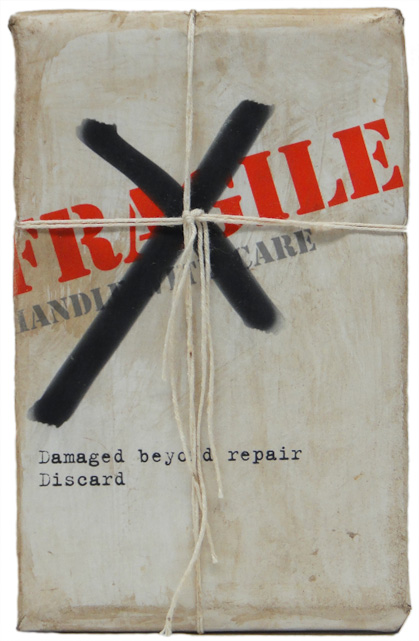
For “An Inventory of Al Mutanabbi Street” More than 250 book artists are making books related to “An Inventory of Al Mutanabbi Street”, a series of exhbitions coordinated by Beau Beausoleil and Sara Bodman. Al-Mutanabbi Street, the historic center of Baghdad bookselling and the heart and soul of the Baghdad literary and intellectual community, was devastated by a car bomb on March 5th, 2007. More than 30 people were killed and more than 100 wounded. Fragile, is a volume wrapped in paper on which the words “Fragile, Handle with care” have been stenciled then crossed out. The message, “Damaged beyond repair, Discard”, remains. The packaged book, tied tightly with twine and not meant to be opened, focuses on the irreparable loss.
Visions
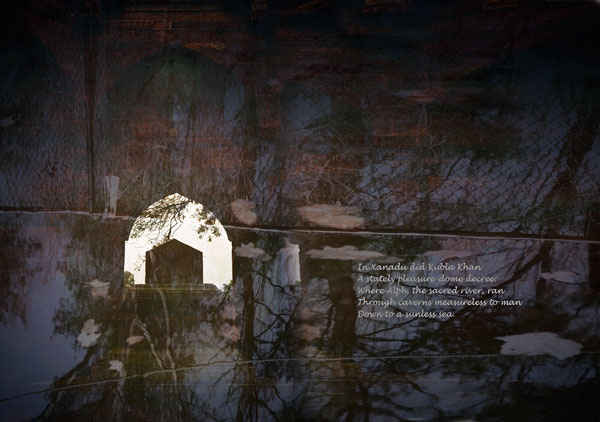
7” x 5”, 15 pages, Edition size 15. Printed on the HP Indigo 5500 on Mohawk Superfine 80# cover by Acme Bookbinding. Lucinda Handwriting font text. Case binding of Asahi fabric over boards with gold spine. Title and author gold-foil stamped using Mistral font on gold oriental paper. Endsheets of mustard gold Lokta paper. Housed in gold organza bag with gold drawstring ties. Using Samuel Taylor Coleridge’s poem “Kubla Kahn or A Vision in a Dream, A Fragment”, composed in 1797 after an opium induced dream, this book incorporates images from three related bodies of work. The vision shown is of a savage place, with holy and enchanted caverns, walls, towers and a sacred river where “The shadow of the dome of pleasure floated midway on the waves”. These haunting images of submerged architectural passageways, lit from within, reflect the branches of trees and illuminate floating leaves and flowers. A beautiful destruction. Of the book Priscilla Juvelis says, “The book is often dark – but shot with streaks of light, mysterious and romantic enough for even Kubla Kahn. “It can be ordered from Priscilla Juvelis Books for $500.
Missing Pieces
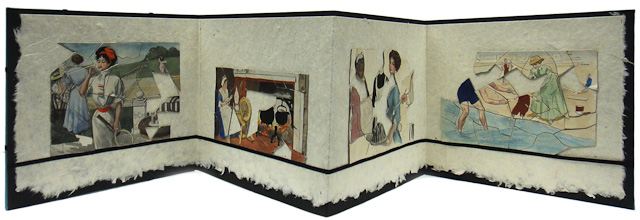
6.5 x 7.5 inches closed, 6.5 x 29 inches open, 4 pp. Unique concertina book. A collection of original watercolors which had been cut into puzzle pieces, were found in an envelope in an antique shop. Although there were missing pieces, when assembled there were four individual images which had been painted onto index cards. Collaged onto Lama Li paper mounted on Arches cover black with a black grograin ribbon as a base, the back and front cover are book cloth over board.
7 Stages of Woman
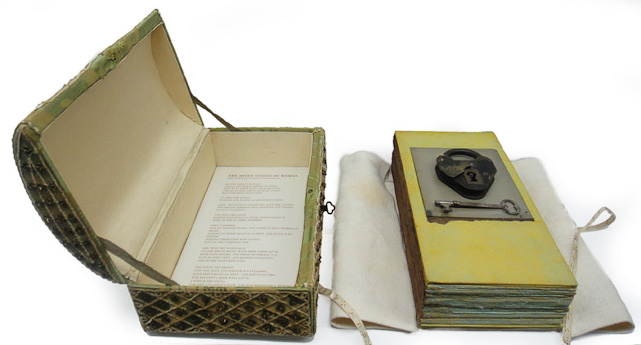
9.75 x 5.875 x 2.25 inches, 7pages. Unique artist’s book, made from Katie MacGregor’s lime green handmade paper over multiple layers of mat board in which dimensional objects, including brass stencils for numbers 1 through 7 unexposed glass negatives, padlocks and keys are embedded. A vintage green silk dome lidded box lined with ivory silk, vintage linen napkin hemmed to size of book and tied with tea-dyed trim enabling book to be removed from box. Of the book Priscilla Juvelis says, “The book itself is a stunning collage of found objects, so arranged as to articulate real beauty. Whether the images are embedded below glass, on glass, recessed without glass the reader / viewer is confronted with the inevitable passing of time as their lives progress and the secrets kept in the past or future.”
How Do I Love Thee
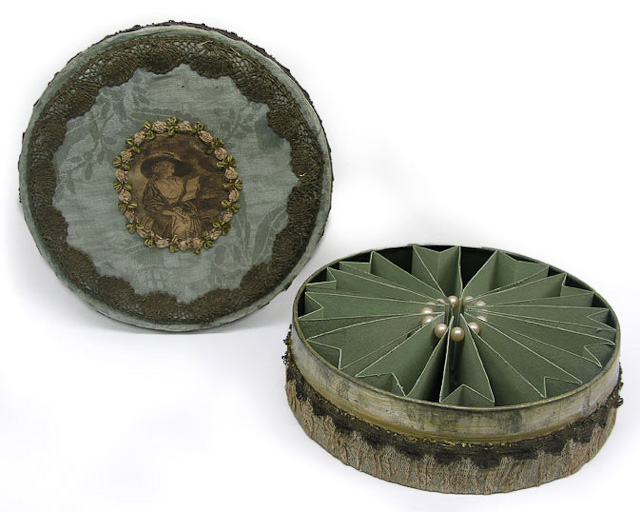
80″ round sunburst concertina separated with pearls into, 24, 2 3/8″ high pages. Pigment printed on Katie MacGregor’s handmade paper and housed in a vintage silk covered metal box 7″ in diameter by 2 3/8″ deep. Elizabeth Barrett Browning wrote Sonnets from the Portuguese, a collection of 44 love sonnets, chronicling the period leading up to her 1846 marriage to poet Robert Browning. One of the most prominent poets of the Victorian era, Elizabeth was an invalid and found it difficult to believe that Browning, who called her “my little Portuguese”, was truly in love with her. These sonnets explore that concern. Sonnet number 43, which begins “How do I love thee?”, is perhaps the most famous and is the subject of this book / box.
Album
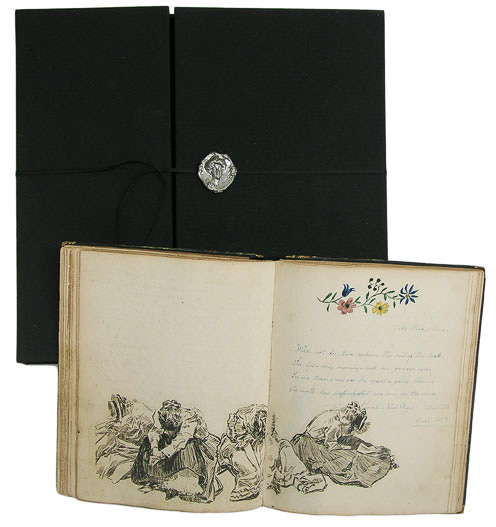
6 x 8 inches, 118pp. Unique altered book. This original autograph album with the owner’s name, “Alma Blydenburge”, stamped in gold on the front within a decorative gilt rule, was rebound using the original covers with a black cloth spine and new sewing. The book is housed in a black cloth over boards box made by Mary McCarthy. Opening in front with recesses for white kid gloves, an embroidered linen handkerchief and a cross-stitched pink ribbon book mark, the front panels close with a black ribbon tie secured with pewter rondel. The artist’s statement reveals that Alma Blydenburge was born in 1811 in Smithtown, Suffolk, New York. She was 21 when she began keeping the album in 1832. At about the same time she married Richard Smith. She died in 1883 at age 52. There are five pages with original watercolors of flowers or plants and one calligraphic page. On most pages the elegant, feminine penmanship found in the album have illustrations of Charles Dana Gibson’s characterizations of the American feminine ideal transferred onto the original album pages with alcohol gel. Priscilla Juvelis descrbes it as “A charming look at a past that seems light years away from today.”
Garden of Eden

11” x 5”, opening to 33 inches, 12 pages. Box 12-1/8 x 6 x 6 inches. Unique book. The book contains images of Durer’s Adam and Eve, Simone Martine’s Angel Michael and a serpent from a natural history source. The images and the text, Robert Frost’s poem “Nothing Gold Can Stay,” are pigment printed in black on orange Mi Tiens paper, collaged onto Arches cover black. The poem is printed with Bickham Script Pro and the title uses the typeface James II WF. The apples, held by the figure in each of the three images, are of copper leaf. Housed in a wood box with vines carved into the domed lid, the book sits on top of a specimen of poison ivy encased in a block of Acrylic. A black grosgrain ribbon lifts the book. The verso of the concertina is a continuous image of a bucolic landscape from a sheet of decorative black and orange Mi Tiens paper. Priscilla Juvelis says: “An arresting juxtaposition of text and image and object, this Garden of Eden is one that can endure. A most provocative presentation of Robert Frost’s poem, “Nothing Gold Can Stay” relating the natural world to moral questions.”
SerpentStone
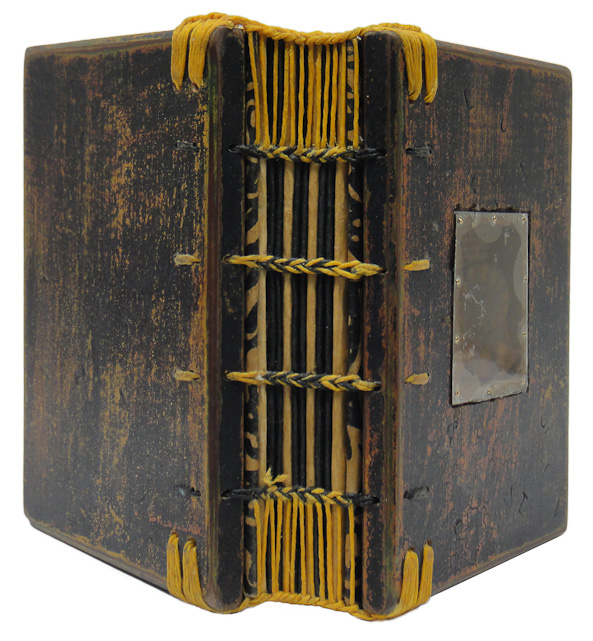
5 x 3.5 inches, 128 pages handmade paper, 12 pages mica. Ethopian Coptic binding with wood covers, a fossilized ammonite embeded behind mica and a leather clasp. Unique book. Housed in a wood and plexiglas box. In medieval Europe, fossilised ammonites were thought to be petrified snakes, and were called “snakestones” or, more commonly in medieval England, “serpentstones”. They were taken to be evidence for the actions of saints such as Saint Hilda and Saint Patrick. Traders would occasionally carve the face of a snake into the empty, wide end of the ammonite fossil and sell them to the public. Ammonites from the Gandaki river in Nepal are known as saligrams, and are believed by Hindus to be a concrete manifestation of God or Vishnu.
Happily Ever After

8 x 6 inches; 21pp. plus laid in colophon on transluscent vegetable vellum paper digitally printed in brown ink. Unique artist’s book on LamaLi paper toned with metallic pigment Hand sewn three-piece case binding with black leather spine and bookcloth painted in copper metallic tones to match the pages. The title is engraved on the front panel below a small (1-3/4 x 1 inch) metal dragon. The book is housed in a matching slip case of black cloth over boards toned bronze at edge,s with title engraved in dull silver on the front. The images are adapted from SLAV FAIRY TALES translated and illustrated by Emily J. Harding. The text, written by the artist, is pigment printed with the images, using Lucinda Handwriting and Lucinda Grande fonts. The colophon / artist’s statement starts, “This romantic fairy tale is set in never-never land with archetypal characters and motifs” and closes with “A symbolic psychological mirror, mythic childhood stories like this may well shape our adult lives.” A sample of the text is “I am made to work hard / at menial tasks – / spinning flax into gold, / cleaning the scullery or / taking care of geese. / Or I have been placed under a spell. “Priscilla Juvelis says, “We all know these stories; not all of us realize their effects on our lives. The modern-looking metallic pages on black ground combine with the “retro-looking” images to bring a strangely contemporary sensibility to our oldest archetypes.”

